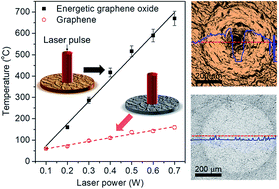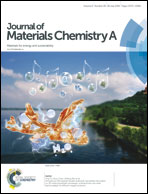A free-standing laser energy converter based on energetic graphene oxide for enhanced photothermic ignition†
Abstract
The dramatic temperature rise of energetic materials when using only millisecond pulses of light is very important for photothermic ignition. Here we demonstrate a free-standing laser energy converter based on energetic graphene oxide, which exhibited an ultrafast and large temperature rise from 21 to 670 °C within 8.7 ms during the irradiation of laser pulses, while the temperature of the graphene-based laser energy converter can only be raised from 21 to 170 °C under the same conditions. The reason for the unexpected and much larger temperature rise of energetic graphene oxide than graphene was studied by laser scanning microscopy and thermal analysis, which indicated that the temperature rise is strongly dependent on the content of oxygen-containing groups in energetic graphene oxide. The combination process of focused ion beam and transmission electron microscope characterization was utilized for the direct observation of the layer-stacked structure in free-standing graphene oxide and graphene membranes. Furthermore, the initiating energy of laser initiators was 40% decreased by adding a thin layer of the free-standing laser energy converter based on energetic graphene oxide, which shows great potential for developing photothermic ignition with low initiating energy.



 Please wait while we load your content...
Please wait while we load your content...